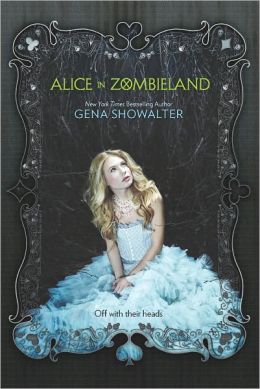Alice in Zombieland, Through the Zombie Glass, and The Queen of Zombie Hearts, by Gena Showalter
Oct 20
2014

I am a huge Alice in Wonderland nerd, but I've had some bad experiences with Alice-inspired rewrites. (I'm looking at you, Frank Beddor's The Looking Glass Wars. You were abysmal.) After years of buying—and regretting—these novels, I swore off them for good... until I saw a “specially priced” copy of Gena Showalter's Alice in Zombieland at my local Target, and that red-and-white 20% off sticker was enough to overcome my embargo. (My willpower in these matters is not strong.) I finished the book in a couple of hours and immediately zoomed out to pick up the two sequels: Through the Zombie Glass and The Queen of Zombie Hearts.
When 16-year-old Ali Bell's family dies in a car accident, she suddenly gains the ability to see the creatures that haunted her father: spirit-eating zombies. Ali can't help but wonder if she's going crazy, but she soon discovers she's not the only person at her new school who can see monsters—tattooed, troublemaking Cole Holland sees them, too, as does his circle of ass-kicking, name-taking friends. Ali and Cole are instantly attracted to one another, but their tempestuous relationship is threatened by their own insecurities, the machinations of an evil corporation, and (of course) the undead.
The White Rabbit Chronicles starts off strong. Alice in Zombieland plunges readers into a fast-paced blend of zombie-slaying and sexual tension, and Showalter gets a lot of minor (but important!) details exactly right. For example, at the beginning of the book Ali is devastated by her family's deaths, so the plot jumps forward several weeks, giving her time to grieve. (So many teen books act like the deaths of family members are minor inconveniences; you have no idea.) And when a beautiful, confident girl at Ali's new school befriends her, the girl doesn't have an ulterior motive—she's just really cool! Usually, “gorgeous and popular” is teen-book code for either “secretly evil” or "plagued by an eating disorder", so it was a pleasure to read a book depicting female friendship as quirky, supportive, and fun.
Sadly, the quality dips as the series progresses. While the books are stuffed with sexuality and violence, Showalter zealously avoids profanity, and the resulting “hecks” and “dangs” are awkward. The zombie mythology is murky, and too many problems are solved by Ali suddenly exhibiting a never-before-seen magical power. Most irritating of all, the author starts matching up her characters like she's marrying off her Barbies. Seriously, every teen romance in this series is the characters' One True Love—at one point, Ali describes a short-lived breakup with Cole as “the toughest thing [she had] ever gone through”, which, considering she had recently endured torture, zombie possession, and the deaths of most of her family members, was intensely eye-roll-inducing.
But while I stand by these criticisms, they didn't stop me from zipping right through the books. The White Rabbit Chronicles are lively, sexy, and fun, with memorable characters and plenty of action (of all sorts). They weren't perfect, but fans of YA paranormal romance and Alice in Wonderland—yes, even those of us who were burned by Mr. Beddor's The Looking Glass Wars—will find plenty to enjoy.
When 16-year-old Ali Bell's family dies in a car accident, she suddenly gains the ability to see the creatures that haunted her father: spirit-eating zombies. Ali can't help but wonder if she's going crazy, but she soon discovers she's not the only person at her new school who can see monsters—tattooed, troublemaking Cole Holland sees them, too, as does his circle of ass-kicking, name-taking friends. Ali and Cole are instantly attracted to one another, but their tempestuous relationship is threatened by their own insecurities, the machinations of an evil corporation, and (of course) the undead.
The White Rabbit Chronicles starts off strong. Alice in Zombieland plunges readers into a fast-paced blend of zombie-slaying and sexual tension, and Showalter gets a lot of minor (but important!) details exactly right. For example, at the beginning of the book Ali is devastated by her family's deaths, so the plot jumps forward several weeks, giving her time to grieve. (So many teen books act like the deaths of family members are minor inconveniences; you have no idea.) And when a beautiful, confident girl at Ali's new school befriends her, the girl doesn't have an ulterior motive—she's just really cool! Usually, “gorgeous and popular” is teen-book code for either “secretly evil” or "plagued by an eating disorder", so it was a pleasure to read a book depicting female friendship as quirky, supportive, and fun.
Sadly, the quality dips as the series progresses. While the books are stuffed with sexuality and violence, Showalter zealously avoids profanity, and the resulting “hecks” and “dangs” are awkward. The zombie mythology is murky, and too many problems are solved by Ali suddenly exhibiting a never-before-seen magical power. Most irritating of all, the author starts matching up her characters like she's marrying off her Barbies. Seriously, every teen romance in this series is the characters' One True Love—at one point, Ali describes a short-lived breakup with Cole as “the toughest thing [she had] ever gone through”, which, considering she had recently endured torture, zombie possession, and the deaths of most of her family members, was intensely eye-roll-inducing.
But while I stand by these criticisms, they didn't stop me from zipping right through the books. The White Rabbit Chronicles are lively, sexy, and fun, with memorable characters and plenty of action (of all sorts). They weren't perfect, but fans of YA paranormal romance and Alice in Wonderland—yes, even those of us who were burned by Mr. Beddor's The Looking Glass Wars—will find plenty to enjoy.
Posted by: Julianka
No new comments are allowed on this post.
Comments
No comments yet. Be the first!